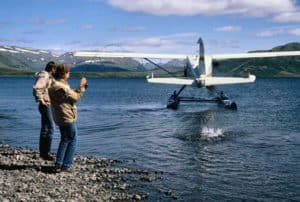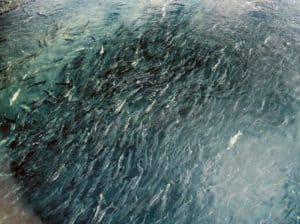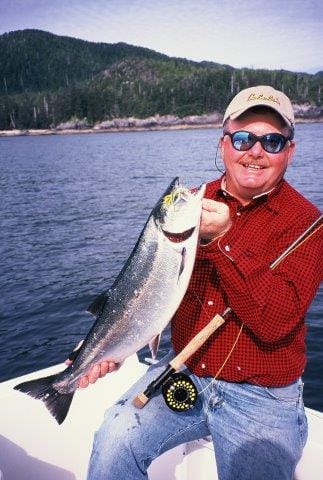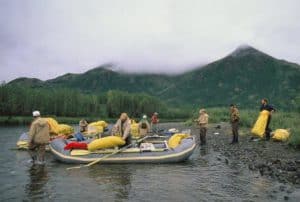by Bob McNally
Ours was the second float plane into Kagati Lake, headwaters of the fish-filled Kanektok River, on Alaska’s west-central coast.

An angler battles a salmon as the float plane he just arrived in taxis away for take off. Such fly-in spots to remote areas of Alaska is among the best of the best for visiting anglers.
We were about 90 minutes behind the first plane that had half our eight-man fishing group. So when we circled the Kanektok River outflow at Kagati Lake, we could see some of our party of anglers from the first plane already had unpacked and assembled tackle. They were standing and fishing on gravel bars in the vodka-clear river.
As we buzzed our friends in the float plane, we saw they were surrounded by, and fishing for, thousands of salmon —mostly pinks or humpbacks and sockeyes—stacked shoulder-to-shoulder in colorful, undulating waves. The sockeyes stood out bright as ripe strawberries in the sun-washed, transparent river. The pea-green-colored heads, bright-orange flanks and large size of the sockeyes made them easy to identify from the smaller, mottled-colored “humpies.”

Mass spawning of Alaska salmon is a sight to behold for visiting anglers, and the fishing is outstanding.
Our pals literally were standing in a salmon factory, and to the man, everyone was hooked fast to a fish. For several minutes we circled, enjoying one of the more unique sights any of us in the float plane had ever seen, watching from the air as four fishermen hooked, played and released salmon after salmon.
Finally, the pilot set the plane down on Kagati Lake, and we taxied to a gravel bank on which our campsite for the evening had been set by the outfitter. The plane door was opened, I stepped out onto a pontoon, and from shore friend Bob Montgomery shouted a hello with a broad smile and dancing eyes like only a fisherman catching fish can have.

Author Bob McNally has fished Alaska often. He says visitors can tap the state’s excellent fishing a number different ways.
“Watch this!” he shouted with a shark’s grin to our newly arrived bunch of anglers, who now all stood on the float-plane’s pontoon over 4-feet of air-like water.
My buddy arched a long cast toward us, and the spoon settled to the surface about 2 feet from our pontoon. The orange-silver “Pixie” flashed a time or two as it sank, but it hadn’t moved a foot when three humpies shot up from the bottom toward it. The first 4-pounder slammed the spoon sideways, but before it could get a good grip on the lure, a second salmon ripped the artificial from the first fish’s mouth. Bob set the hook, and the humpie fought and boiled the surface all around our feet.
“Our humpback salmon are so plentiful and mean we call ’em ‘humpies from hell,’” said guide Dan Bechtold, of Dave Duncan & Sons Outfitters. He stood smiling beside my buddy on the bank, while wearing a unique Alaskan T-shirt bearing that same salmon message and a cartoon showing a school of toothy, crazed “attack” humpies.
That trio of aggressive humpies at the plane, and Dan’s laughable T-shirt, set the stage for one of the most remarkable fishing trips any of our party ever experienced. Over the next eight days we covered 100 miles on the Kanektok River in four rafts, enjoying wilderness camping and remote angling that Alaska is famous for.
We caught countless humpie, sockeye, chum and silver salmon and char, plus fat, colorful and high-leaping rainbow trout. We also caught some grayling and a few heavyweight Chinook or king salmon.
It was without question the most perfect fishing trip possible to Alaska, with all the pristine wilderness trappings and highlights available. We saw huge numbers of eagles, brown and black bears, moose, wolves, abundant other game, and not another person outside of our group for a week in the wilds. At the beginning of the float we were surrounded by sky-reaching snow-capped mountains. It ended just a few miles from the cold, salty and dangerous Bering Sea.
Such fly-in float trips are the best of the best for a fisherman bent on taping Alaska’s rich waters. But it is far from the only way to get in on some of the 49th state’s spectacular angling.
Another great way to fish the state is out of a base lodge, with anglers venturing out daily in boats or airplanes to various locations. This lodge-type arrangement often is a fly-in spot with a required minimal short hop in a small plane.
My first trip to Alaska was to the Aniak River, where lodge and camp owner LaMont Albertson Jr. had a plush tent camp many miles upriver from his home in Aniak. We traveled to the camp by float plane, then ran out from the tent camp daily via small boats powered by jet outboards. It was mostly wade fishing, and the non-stop action from salmon and char was unforgettable.
Trips to the Aniak can be set up at the Aniak River Lodge.
In some areas anglers can fly into a large city or town, where they are then transported to a fishing lodge via car or small airplane. Visitors should understand that small airplanes are like automobiles to most native Alaskans. In fact, there are about as many pilots in the state as there are people with conventional driver’s licenses.
One of the most accessible, yet remarkably fish-rich areas of southeast Alaska is Ketchikan (well south of Anchorage), where daily jet air service is available out of Seattle and other U.S. cities. Ketchikan also is a popular cruise ship destination, and fishing trips can be set-up while on ships.
Beacon Hill Lodge offers outstanding Ketchikan area fishing in freshwater rivers and in saltwater. Fishing there during one trip with owner and guide Ron Moyer we caught silver salmon (cohos) in the open Pacific Ocean on every cast. The fish weighed 8 to 15 pounds and hit streamer flies and spoons with abandon. In a typical day of such fishing we watched eagles, humpback whales, seals and orcas, making the fishing adventure truly unforgettable.
Saltwater fishing out of Ketchikan and some other Alaskan coastal areas also is spectacular for halibut, snapper, sea bass, ling cod and other species.
Anyone visiting Alaska can arrange for an easy day trip of fishing out of most of the larger towns and cities, including Anchorage. Such day-long adventures during the peak of the summer salmon season can be remarkably successful. Visitors can do some fishing on their own if they have a rental vehicle and tackle.
But with limited time and area fishing knowledge, a day charter with a guide is advised, which should be set up in well advance through a tourist bureau or travel agent, who invariably are only too willing to help anglers succeed in their Alaskan fishing mission.
The Union Sportsmen’s Alliance website is designed to provide valuable articles about hunting, fishing and conservation for members of AFL-CIO affiliated labor unions and all sportsmen and sportswomen who appreciate hunting and fishing and want to preserve our outdoor heritage for future generations. If you would like your own story and experience from the outdoors to be considered for our website, please email us at USAmembers@unionsportsmen.org.




